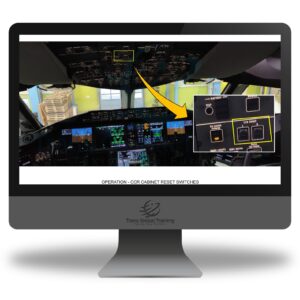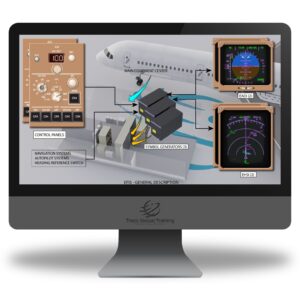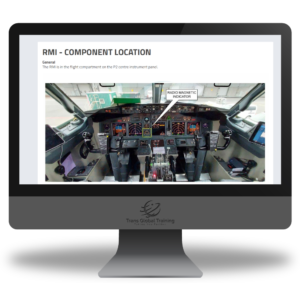
Shop
Boeing 777 GE90 & RR General Familiarisation
£375.00
Our Courses Scale Perfectly To Any Device
About our Online Self-Study Course
The Boeing 777 GE90 & RR General Familiarisation course has been designed to give you a complete technical overview of all aircraft systems. The course covers all mechanical and avionics systems, This self–study online Boeing 777 GE90 & RR General Familiarisation course will take approximately 40 hours of study. Students must pass the multi-choice question at the end of each ATA chapter before the next ATA chapter is unlocked. A completion certificate is issued on successful completion of the course.
Our Boeing 777 GE90 & RR General Familiarisation course is produced to a minimum of ATA 104 Level 1 and EASA Part 66 Level 1 knowledge levels and course completion time will be approximately 40 hours. This information is stated on the certificate.
You have 12 months from enrollment to begin the course and after starting, 6 months to complete the course. You have a further 90 days to review the course after completion.
Click on the DESCRIPTION below for course syllabus and more details. Please click here to view our sample course
When checking out, please ensure you use the student’s name. To enroll multiple students in the same course, please make separate transactions or contact us for team discounts
Description
BOEING 777 GE90 & RR GENERAL FAMILIARIZATION COURSE
ABOUT
The Boeing 777 GE90 & RR General Familiarisation course meets ATA 104 Specification Level I: General Familiarisation; A brief overview of the airframe, systems and powerplant as outlined in the Systems Description Section of the Aircraft Maintenance Manual.
The course also complies with EASA’s knowledge LEVEL 1 definition as contained in Regulation EU No. 1321/2014, Part 66, Appendix III Basic Knowledge Requirements;
A familiarization with the principal elements of the subject, with the objective;
(a) The applicant should be familiar with the basic elements of the subject.
(b) The applicant should be able to give a simple description of the whole subject, using common words and examples.
(c) The applicant should be able to use typical terms
This self-study online Boeing 777 GE90 & RR General Familiarisation course will take approximately 40 hours of study. Students must pass a quiz at the end of each ATA chapter before the following ATA chapter is unlocked. A completion certificate is issued on successful completion of the course.
Course objectives: upon completion of the course, the student will be able to identify safety precautions related to the airframe, it’s systems and powerplant.
Identify maintenance practices important to the airframe, it’s systems and powerplant
Define the general layout of the aircraft’s major systems.
Define the general layout and characteristics of the powerplant.
Identify special tooling and test equipment used with the aircraft.
SYSTEM REQUIREMENTS
Our courses scale perfectly to PC, Laptop, tablet, android and iPhone. You must have an internet connection to use our courses.
STUDY TIME
Course completion time varies with the individual; however, we estimate approximately 40 hours will be required. You have 6 months to complete the course and can stop and restart at the same position with your progress saved. Once completed you will have a further 90 days to review the course.
SUPPORT
Should you require any assistance during your course, please contact us and we will assist you during normal working hours.
WHY USE OUR GENERAL FAMILIARIZATION COURSES?
Our online Boeing 777 GE90 & RR General Familiarisation course provides an excellent solution for training engineers or company support staff, giving the required in-depth aircraft type knowledge with the advantage of distance learning.
WHY BUY FROM US?
Our Boeing 777 GE90 & RR General Familiarisation course is designed and produced by EASA and UK CAA B1/B2 Engineers, Type instructors and Part 147 Training Managers. We ensure each course covers all relevant ATA chapters.
DETAILED COURSE SYLLABUS
DETAILED COURSE SYLLABUS
The Boeing 777 GE90 & RR General Familiarisation course begins with an aircraft type introduction, then covers each ATA chapter to approximately Part 66 Level 1;
ATA 00 –12 – Introduction, Principal Dimensions and Areas, Aircraft Range Capability, Fuselage Station Diagram, Zone Diagrams, Finding A Zone, Aircraft Jacking, Levelling, Servicing Points, Towing, Equipment Centres, Main Equipment Centre, Access to The Main Equipment Centre, Airplane Information Management System (AIMS), Electrical Load Management System (ELMS), Systems Card Files.
ATA 21 AIR CONDITIONING – General Description, Temperature Control, Distribution, Ventilation, Equipment Cooling, Pressurization, Forward Cargo Compartment Heating, Aft And Bulk Cargo Compartment Heating, Crew Rest Area Heating, Supplemental Heating, Control, Indications, Tests.
ATA 22 AUTO FLIGHT – Autopilot Flight Director System, AFDS – Main Equipment Centre Component Location, Thrust Management Computing System (TMCS), TMCS – Flight Deck Component Locations.
ATA 23 COMMUNICATIONS – Description and Operation, Flight Deck Communications, High Frequency Communication System, Very High Frequency Communication System, HF & VHF System – Flight Deck Component Locations, Satellite Communications System, SATCOM System, SELCAL, Emergency Locator Transmitter, Passenger Address System, Cabin Services System, Service Interphone System, Service Interphone System, Service Interphone System – Jack Locations, Cabin Interphone System, Ground Crew Call System, Flight Interphone System, Static Dischargers, Voice Recorder System, Flight Deck Entry Video Surveillance System.
ATA 24 ELECTRICAL POWER – Electrical Power Introduction, Electrical Power – Power & Control, Electrical Power – Distribution, Electrical Power – Component Locations, Electrical Load Management System (ELMS), ELMS – Component Locations, AC Generation, AC Generation – APU Generator And IDG Power Systems, AC Generation – Backup Generator Power System, AC Generation – Component Locations, AC Generation – Main Equipment Centre – Component Locations, DC Generation, DC Generation – Subsystems, DC Generation – Component Location – RAT, DC Generation – Description, Standby Power, Flight Controls DC Power, External Power, External Power – Ground Service Switch, Electrical Power – Control, Electrical Power – Indication.
ATA 25 EQUIPMENT/FURNISHINGS – Passenger Compartment Equipment and Furnishings, Interior Configuration, Passenger Compartment, Emergency – Escape Ropes, Emergency – Overwater Survival Equipment – Life Vests, Emergency – Emergency Locator Transmitter, Emergency Evacuation Signal System, Off–Wing Escape System.
ATA 26 FIRE PROTECTION – Fire Protection – Introduction, Fire Protection – System Tests, Fire Protection – Fire/Overheat Test, Engine Fire Detection, Engine Fire Detection, Engine Fire Detection – Flight Deck and MEC Component Locations, Engine Fire Detection – Indications, Engine Turbine Overheat Detection – Rolls Royce Trent 800, Lavatory Smoke Detection, Lavatory Smoke Detection – Operation – Indications, APU Fire Detection – Introduction, APU Fire Detection – Flight Deck and MEC Component Locations, APU Fire Detection – Nose Landing Gear Component Locations, APU Fire Detection – Indications, Lower Cargo Compartment Smoke Detection, Lower Cargo Compartment Smoke Detection – Flight Deck Component Locations, Wheel Well Fire Detection, Wheel Well Fire Detection – Component Locations, Duct Leak and Overheat Detection, Electrical/Electronic (E/E) Cooling Smoke Detection, Engine Fire Extinguishing, Engine Fire Extinguishing – Component Locations, Lower Cargo Fire Extinguishing, Lavatory Waste Compartment Fire Extinguishing.
ATA 27 FLIGHT CONTROLS – Flight Control Systems Introduction, Flight Controls, Flight Control Shutoff Valves, PFCS Operational Overview, PFCS Modes Of Operation, PFCS – Analogue Interfaces, Actuator Control Electronics (ACE), PFCS – Flight Controls ARINC 629 Bus Interfaces, Primary Flight Computers (PFCs), PFC – Control Laws, PFCS – Electrical Power, Hydraulic Power Distribution, PFCS Roll Control, Flaperon and Aileron Components, Spoiler and Speedbrake Control, Auto Speedbrake Control, Yaw Control, Rudder Control Component Locations, Pitch Control – Elevator, Pitch Control – Stabilizer, Flight Controls Synoptic Display, High Lift Control, High Lift Control System (HLCS), High Lift Control System (HLCS) – Alternate Mode, Flap/Slat Electronics Unit, Flap/Slat Component Locations, Flap Skew Detection System, Leading Edge Slats Components, Slat Skew Detection System, Flap/Slat Load Relief, Autoslat Extension, Flap/Slat Position Displays, HLCS Maintenance Page Format.
ATA 28 FUEL – Fuel System, Fuel Storage, Fuel Storage – Tank Vent System, Pressure Refuel, Pressure Refuel – Component Locations, Pressure Refuel – Component Locations, Engine Fuel Feed, Engine Fuel Feed – Component Locations – Tanks, Engine Fuel Spar Valve Battery, Engine Fuel Feed, Engine Fuel Feed – Indications, APU Fuel Feed, APU Fuel Feed – Fuel Supply Line And Shroud, APU Fuel Feed – Indications, Defuel, Defuel – Operation, Fuel Jettison, Fuel Indicating, Fuel Indicating – Fuel Quantity Measuring Stick Assembly.
ATA 29 HYDRAULIC POWER – Hydraulic System Introduction, Hydraulic Power – Component Locations, Hydraulic Power – Operation, Hydraulic Power – Indications, Hydraulic Power – Operational Tests, Main Hydraulic Systems – Hydraulic System Summary, Main Hydraulic Systems, Main Hydraulic Systems – HYDIMS, Main Hydraulic Systems – Controls, Main Hydraulic Systems – Left and Right Systems, Main Hydraulic Systems – Centre System, Main Hydraulic Systems – Centre Hydraulic Isolation System, Ram Air Turbine System.
ATA 30 ICE AND RAIN PROTECTION – Ice and Rain Protection, Wing Anti–Ice, Wing Anti–Ice – Operation, Wing Anti–Ice – System Tests, Engine Anti–Ice, Engine Anti–Ice Indication, Engine Anti–Ice – System Tests, Pitot and Static (Air Data Sensors), Flight Deck Window Anti–Ice System, Windshield Wiper System, Drain and Water Supply Line Heating, Ice Detection System.
ATA 31 FLIGHT DATA RECORDER SYSTEM – Airplane Information Management System (AIMS), Airplane Information Management System (AIMS), AIMS Cabinets, Avionics Systems Supported By AIMS, AIMS – Main Equipment Centre Component Locations, AIMS – Data Conversion Gateway Function, AIMS – System Ground Tests, LRU Tests and Operational Tests, Primary Display System, Primary Display System, Primary Display System – OPAS Interface, Primary Display System – Synoptic Formats, Primary Display System – Maintenance Pages, Ground Manoeuvre Camera System, ACMS – Aircraft Condition Monitoring System, Systems Card Files, Warning Electronic System, Warning Electronic System – Component Location, Flight Data Recorder System, Clocks, Flight Compartment Printing System.
ATA 32 LANDING GEAR – Landing Gear, Nose Landing Gear, Main Landing Gear, Main Landing Gear Downlock Pins, Gear Door Ground Operation, Landing Gear Door Unsafe Lights, Landing Gear Control System, Alternate Extension System, Component Location, Nose Wheel Spin Brakes, Main Landing Gear Wheels, Brake System, Antiskid/Autobrake System, Parking Brake System, Brake Temperature Monitoring System, Nose Steering, Tail Strike System, Air/Ground System, WOW Load Sensor, Proximity Sensor System (PSS), Landing Gear Position Indicating and Warning System, Indication.
ATA 33 LIGHTS – Lights, Flight Compartment Lights, Flight Compartment Lights – Spare Lamps, Passenger Compartment Illumination, Service and Cargo Loading Lights, Service and Cargo Loading Lights – Main Wheel Well Locations, Service and Cargo Loading Lights – Nose Wheel Well Locations, Service and Cargo Loading Lights – Cargo Loading Lights, Exterior Lights, Exterior Light Control, Emergency Lighting, Emergency Lighting – Exit Signs, Emergency Lighting – Slide Lights, Emergency Lighting – Power Supplies, Emergency Lighting.
ATA 34 NAVIGATION SYSTEMS – Navigation Systems, Air Data Inertial Reference System – ADIRS, ADIRS – Component Location – Flight Deck, ADIRS – Component Location, Pitot–Static/Air Data Standby Instruments, Pitot–Static/Air Data Standby Instruments, Pitot–Static/Air Data Standby Instruments – Flight Deck Component Location, Pitot–Static/Air Data Standby Instruments – External Component Location, Pitot–Static/Air Data Standby Instruments, Pitot–Static/Air Data Standby Instruments – Standby Airspeed Indicator/Altimeter, Standby Magnetic Compass, Standby Attitude Reference System, VHF Omnidirectional Ranging System – VOR, Air Traffic Control/Mode S Transponder System – ATC, Distance Measurement Equipment System – DME, Automatic Direction Finder System – ADF, Global Positioning System – GPS, Radio Altimeter System – RAD ALT, Weather Radar System – WXR, WXR System – Component Locations, Traffic Alert And Collision Avoidance System – TCAS, Ground Proximity Warning System – GPWS, GPWS – Flight Deck Component Locations, Flight Management Computing System – FMS, Instrument Landing System – ILS, ILS – Flight Deck Component Location, ILS – Component Locations, ILS – EFIS ILS Controls, Marker Beacon System.
ATA 35 OXYGEN SYSTEMS – Oxygen, Oxygen – Indications, Crew Oxygen, Crew Oxygen – Overboard Discharge Indicator, Portable Oxygen, Passenger Oxygen – Chemical, Passenger Oxygen – Gaseous, Passenger Oxygen – Overboard Discharge Port.
ATA 36 PNEUMATIC SYSTEM – Pneumatic, Pneumatic – Component Locations, Pneumatic – Indications – Air Synoptic Display, Pneumatic – Indications – Air Supply Maintenance Page, Pneumatic – System Tests.
ATA 38 WATER AND WASTE – Water and Waste Systems, Water and Waste – General Description, Potable Water Pressurisation, Water Storage and Distribution, Water Storage and Distribution – Service Panel Component Locations, Water Heating, Water Quantity Indication, Grey Water Drain System, Vacuum Waste System, Vacuum Waste System – Bulk Cargo Compartment Component Locations, Vacuum Waste System – Waste Service Panel Component Locations, Vacuum Waste System – Bulk Cargo Compartment Component Locations, Waste Tank Quantity Indication, Water Tank Pressurization.
ATA 45 ONBOARD MAINTENANCE SYSTEMS (OMS) – Central Maintenance Computing System – CMCS, CMCS – Fault Processing Concept.
ATA 46 INFORMATION SYSTEMS – Onboard Network System.
ATA 47 INERT GAS SYSTEM – Fuel Tank Inerting System Functions, Nitrogen Generation System – NGS, NGS Component Location.
ATA 49 AIRBORNE AUXILIARY POWER – Auxiliary Power System, Auxiliary Power System – Component Locations, Auxiliary Power System – Controls, Auxiliary Power System – Controls, Auxiliary Power System – APU Access and Servicing, Engine, Indicating, APU Oil System, APU Fuel System, Air, APU Air – APU Cooling Air System, APU Ignition/Starting.
ATA 52 DOORS – Doors, Entry, Cargo and Access Doors, Passenger Entry Door, Emergency Power Assist System EPAS), Hold–Open Mechanism, Emergency Evacuation Signal System, Escape System, Cargo Doors, Cargo Door System – Electrical Operation, Bulk Cargo Door, Fixed Interior Doors – Flight Compartment Door, Electrical/Electronic Access Hatch, Door Indications.
ATA 71 TO 80 POWERPLANT (GE 90) – GE 90 Powerplant Introduction, Powerplant Installation, Powered Door Opening System (PDOS), Engine – General Description, Engine – Engine Separation, Engine Fuel Control, Airborne Vibration Monitoring, Engine Fuel Distribution, Engine Oil System, Engine Air, Engine Air – Engine Accessories Cooling, Engine Air – Turbine Cooling – (Turbine Active Clearance Control), Engine Air – VSV System, Engine Air – VBV System, Engine Controls, Ignition, Engine Starting, Thrust Reverser System – T/R, Thrust Reverser Actuation System (TRAS), T/R Indicating and Fault Detection – Indications, Power Plant – Engine Hazards.
ATA 71 TO 80 POWERPLANT (RR TRENT 800) – Rolls–Royce Trent 800 Introduction, Powerplant Installation, Powered Door Opening System (PDOS), RR Trent – Engine – General Description, Engine Fuel Control, Airborne Vibration Monitoring (AVM), Engine Fuel Distribution, Engine Oil System, Engine Air – General Description, Air – Accessory/Zone Cooling, Engine Air – Turbine Impingement Cooling, Air – Compressor Control, Engine Controls, Ignition, Engine Starting, Thrust Reverser System, Thrust Reverser Actuation System (TRAS), T/R Indicating and Fault Detection – Indications, Power Plant – Engine Hazards.
















